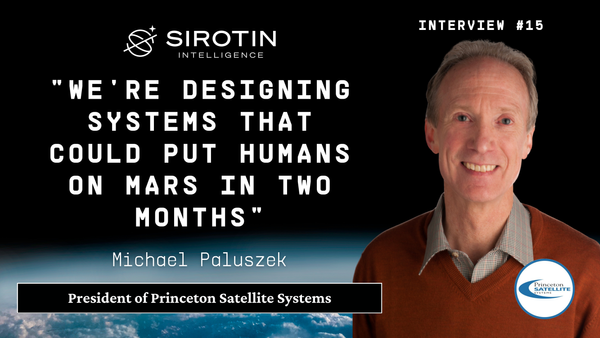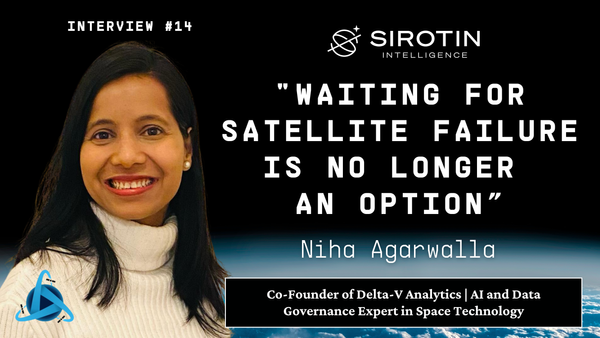Sirotin Intelligence Briefing: Mar 17 - Mar 22, 2025: Russian Satellites Conduct Attack Maneuvers, Space Force Warns Of Narrowing Capability Gap, And Pentagon Tracks China's Orbital Dogfighting Tests
Russian and Chinese satellites execute concerning "attack and defend" maneuvers while Space Force leaders warn of narrowing capability gaps with adversaries. Commercial innovations advance with fusion propulsion and lunar resource extraction that could reshape our cosmic future.

In this week's briefing, Russian satellites execute coordinated "attack and defend" maneuvers in low Earth orbit while Chinese experimental crafts practice orbital dogfighting tactics. Pentagon officials watch silently, their capability gap with adversaries narrowing by the day. "We're at an inflection point," warns Space Force General Michael Guetlein. Meanwhile, commercial players quietly revolutionize our cosmic future—from fusion propulsion that could slash travel time to Pluto from nine years to four (as our Tuesday guest Michael Paluszek of Princeton Satellite Systems explains) to the extraction of lunar Helium-3 worth $50 million per kilogram (detailed Thursday by Jeffrey Max, CEO of Magna Petra). The militarization of space accelerates. The trillion-dollar market emerges. And America's satellites face daily attacks that, if successful, could plunge our infrastructure back to the Dark Ages in less than sixty seconds.
🛡️ Defense Highlights
- 🇷🇺🇨🇳 Pentagon Alert: Russia and China's Space Warfare Tactics Close Critical Capability Gap: US military officials are closely tracking Russian and Chinese satellite maneuvers that suggest aggressive testing of offensive space capabilities. The Pentagon has observed Russian satellites practicing "attack and defend tactics" in low Earth orbit, including exercises where multiple satellites worked together to surround and isolate another satellite, raising concerns about the narrowing capability gap between the US and its adversaries.
- 🇷🇺 🛰️ Russian Satellite Trio Demonstrates Coordinated Attack Maneuvers in Low Earth Orbit: The US Department of Defense has reported that Russian satellites recently engaged in coordinated maneuvers described as "attack and defense" tactics in space. The activity centered around a trio of Russian satellites known as Cosmos 2581, 2582, and 2583, launched from the Plesetsk Cosmodrome in February 2025, demonstrating capabilities that could potentially be used to target hostile spacecraft.
- ⚠️ Space Force General Sounds Alarm: "We're at an Inflection Point" as Adversaries Match US Space Capabilities: Vice Chief of Space Operations Gen. Michael Guetlein has warned that the US is at an "inflection point" in space security, with the capability gap between America and its adversaries significantly narrowing. Speaking at a defense conference, he emphasized the need for the Space Force to pivot from providing space services to becoming a true warfighting force capable of protecting US assets in orbit, noting that hostile nations are now practicing satellite "dogfighting" tactics in space.
- 🤖 Space Force Launches Comprehensive AI Strategy to Transform from Service Provider to Combat-Ready Force: The U.S. Space Force has released a comprehensive strategic plan for integrating artificial intelligence into its operations. This initiative aims to enhance space domain awareness, improve decision-making processes, and optimize resource utilization as space becomes an increasingly contested environment requiring advanced technological solutions to maintain strategic advantages over adversaries.
- 🇨🇦 🇦🇺 Canada-Australia Strike $4.2B Deal to Revolutionize Arctic Defense with Advanced Radar System: Canadian Prime Minister Mark Carney has announced a CAD$6 billion (US$4.2 billion) deal with Australia to develop an advanced Over-the-Horizon Radar system to enhance Arctic defense capabilities. The government will also invest CAD$420 million to expand Canada's year-round military presence in the far north, highlighting Arctic sovereignty as a strategic priority amid changing global interests.
- 🪓 "The Ax": How Program Cancellations Became Space Force's Strategic Weapon in Budget Battles: The Space Force is increasingly relying on program cancellations and terminations—known colloquially as "the ax"—to free up resources for more critical capabilities in response to evolving threats. This strategic approach allows the service to implement its "divest to invest" philosophy, cutting legacy systems and underperforming programs to redirect funding toward emerging technologies and capabilities that can better address the rapidly evolving space domain challenges.
- 🇨🇳 China's "Space Force" Rapidly Advancing Satellite Combat Capabilities, Pentagon Intelligence Reveals: Chinese military space units have significantly accelerated their orbital warfare capabilities, with recent satellite maneuvers demonstrating sophisticated "dogfighting" tactics. According to intelligence reports, China's Strategic Support Force has conducted multiple exercises showing the ability to track, intercept, and potentially disable adversary satellites. These developments mark a concerning milestone in space militarization as Beijing continues rapid expansion of its counter-space program that could threaten critical US military and civilian infrastructure.
💼 Major Space Contracts
- 📊 Space Force Accelerates Commercial Transition Strategy for Legacy Systems Amid Pentagon Budget Overhaul: Vice Chief of Space Operations Gen. Michael Guetlein announced that the U.S. Space Force is looking to offload some legacy capabilities to commercial providers or allies as part of a significant shift in acquisition strategy. This pivot comes amid the Pentagon's broader budget realignment efforts requiring all military services to identify 8% of their 2026 budget for reallocation to higher priority technologies.
- 🔍 Four Commercial Firms Win Groundbreaking Civil Reserve Space Fleet Contracts for Space Surveillance: The Space Force has awarded its first Civil Reserve Space Fleet pilot program contracts to four commercial space situational awareness companies: Numerica Corporation, COMSPOC, ExoAnalytic Solutions, and Slingshot Aerospace. This groundbreaking initiative, modeled after the Air Force's Civil Reserve Air Fleet, represents a significant expansion of partnerships with commercial space surveillance providers to enhance the military's ability to monitor and respond to threats in orbit.
- 📡 Critical GPS Modernization Program Faces Extended Timeline as NTS-3 Launch Slides to Late 2025: The Navigation Technology Satellite-3 (NTS-3), a key U.S. GPS modernization demonstrator, is facing significant launch delays that will impact its near-term testing goals. Originally scheduled for early 2023, the mission has been repeatedly pushed back, with current projections targeting a launch no earlier than late 2025, potentially limiting the program's ability to influence crucial GPS technology decisions and implementation timelines.
- 💰 Gen. Saltzman: Space Force Positioned to Weather Pentagon's 8% Budget Reallocation Storm: Chief of Space Operations Gen. Chance Saltzman stated that the Space Force is well-positioned to weather the Pentagon's mandated funding reprioritization efforts. While all military services must identify 8% of their 2026 budget for potential reallocation, Saltzman expressed confidence that the Space Force's lean structure and focus on critical technologies will allow it to navigate these fiscal challenges without compromising essential capabilities.
🌐 Policy, Geopolitical & Legal Developments
- 🇸🇦 🌍 Middle East Space Strategy Requires Balancing Act: Export Policy Reforms Could Empower Regional Defense: As the US recalibrates its global strategy, a delicate balancing act emerges for space cooperation with Middle Eastern partners, particularly Gulf Cooperation Council states. Security experts argue that if Washington expects regional allies to take greater responsibility for their defense, it must adjust export policies to allow sophisticated satellite capabilities sales while the Space Force develops expertise in conducting foreign military sales of national security space systems to global partners.
- 🇷🇺 🤝 Russia Courts Elon Musk for Mars Collaboration Following European Space Agency Partnership Collapse: Russia's international cooperation envoy, Kirill Dmitriev, announced that Russia expects to hold talks with SpaceX CEO Elon Musk soon about potential collaboration on Mars missions. This outreach follows Russia's 2022 decision to start work on its own Mars mission after the European Space Agency suspended a joint project in response to Russia's military action in Ukraine.
- 🧑🚀 286 Days in Space: NASA's Extended Mission Astronauts Return Safely After Boeing Starliner Complications: NASA astronauts Butch Wilmore and Suni Williams, along with their Crew-9 crewmates Nick Hague and Aleksandr Gorbunov, have safely returned to Earth after splashing down near Tallahassee, Florida. Wilmore and Williams spent 286 days in space—far longer than their originally planned 8-day mission aboard Boeing's Starliner spacecraft due to propulsion issues that required return on SpaceX's Crew Dragon.
- 💵 Controversy Erupts Over $5 Daily Stipend for Stranded Astronauts' Nine-Month Orbital Extension: NASA astronauts Butch Wilmore and Suni Williams, who were stranded in space for nine months instead of their planned eight-day mission, received just $5 per day in "incidentals" pay for their extended stay—approximately $1,430 total. As federal employees on travel orders, they received their standard salaries but no overtime, holiday pay, or hazard pay despite the unexpected extension, prompting President Trump to suggest he would personally cover additional compensation for their ordeal.
- 📈 Former ISRO Chief: "We've Only Scratched 10% of Space Technology's Market Potential": Former Indian Space Research Organisation chief S. Somanath stated that the application penetration of space technology remains small despite huge potential. Speaking at a Confederation of Indian Industry conference, he emphasized that space technology applications have largely been limited to government programs, with only about 10% of the potential market being explored, calling for expanded commercial applications.
- 🚀 NASA Weighs Additional Starliner Test Flight Following Troubled Mission Performance: NASA is considering options for another Boeing Starliner test flight following issues identified in previous missions. This deliberation comes as the agency evaluates the spacecraft's readiness for operational crew transport to the International Space Station, balancing safety concerns with commercial crew program objectives in light of recent challenges with the platform.
- 👨🚀 30 Former NASA Astronauts Endorse Billionaire Isaacman as "Uniquely Qualified" Administrator Candidate: Nearly 30 former NASA astronauts have signed a letter endorsing billionaire Jared Isaacman as the agency's next administrator, calling him "uniquely qualified" to lead NASA at this critical juncture. The astronauts, including Hubble repair mission veteran John Grunsfeld and former Kennedy Space Center director Bob Cabana, are urging the Senate Commerce Committee to quickly hold a confirmation hearing for Isaacman, who is best known for commanding the Inspiration4 and Polaris Dawn private astronaut missions.
🛰️ Technology & Commercial Developments
- ☀️ Ascent Solar Declares Turnaround "Complete" as Space-Grade Solar Tech Secures Defense Contracts: The company (Nasdaq: ASTI) has announced significant progress establishing long-term revenue through space solar solutions, working with multiple strategic partners including a major defense contractor and satellite companies. CEO Paul Warley stated their "challenging turnaround process is in the rear-view mirror," with their flexible thin-film photovoltaic technology now consistently meeting performance requirements for harsh space environments.
- 🔥 Varda's Third Capsule to Push Boundaries of Hypersonic Navigation Technology at Mach 25: Varda Space Industries has successfully deployed its third orbital capsule, W-3, carrying a specialized Inertial Measurement Unit engineered by the US Air Force and ISSI aboard SpaceX's Transporter-13 rideshare mission. The capsule will test the IMU during reentry at speeds over Mach 25, providing critical hypersonic research data before landing at Australia's Koonibba Test Range, marking Varda's second successful mission of 2025.
- 🌙 Mission Complete: Firefly's Blue Ghost Makes History as First Fully Successful Commercial Lunar Lander: Firefly Aerospace and NASA are celebrating the complete success of the Blue Ghost Mission-1 (BGM-1), which has become the first fully successful commercial lunar lander. The spacecraft operated for its entire planned 14-day mission on the lunar surface, successfully running all 10 NASA experiments and transmitting 51 gigabytes of scientific data, capturing remarkable lunar imagery including views of Earth and a solar eclipse.
- 🔭 🇪🇺 Euclid Space Telescope Delivers "Goldmine" of Dark Matter Data Revealing 26 Million Galaxies: The European Space Agency's Euclid telescope has released its first scientific data, showing 26 million galaxies in unprecedented detail with 380,000 classified, providing what ESA scientists called "a goldmine of data" for dark matter and dark energy research. The telescope's wide field of view and advanced instruments reveal large cosmic structures that offer crucial clues about invisible dark matter distribution.
- 🎈🇪🇺🇵🇹 Europe Funds Revolutionary Inflatable Drag Sail to Accelerate Satellite Deorbiting and Reduce Space Debris: A consortium led by Portuguese startup Spaceo has secured a €3 million contract from the European Space Agency to test an inflatable drag sail system designed to swiftly deorbit satellites after mission completion. The SWIFT project will deploy a system that inflates from 20 square centimeters to about 1.5 square meters, increasing atmospheric drag to accelerate orbital decay, addressing space debris concerns.
- 🚀 NASA's Triple Rocket Launch to Illuminate Complex Electromagnetic Dynamics Within Aurora Patterns: NASA is preparing to launch three rockets in rapid succession from Alaska's Poker Flat Research Range as part of a sophisticated aurora experiment. The mission aims to study the complex electromagnetic interactions in Earth's upper atmosphere during auroral activity, with the rockets releasing visible vapor trails that will help scientists visualize atmospheric movements and electric field patterns within the northern lights.
- 💫 James Webb Makes Historic Discovery: Oxygen Detected in Galaxy Just 300 Million Years After Big Bang: Astronomers have detected oxygen in an extremely distant galaxy formed just 300 million years after the Big Bang, the earliest-ever detection of this element in the universe. This groundbreaking discovery, made using the James Webb Space Telescope, provides crucial insights into how the first stars formed and processed elements in the early universe, challenging existing models of cosmic chemical evolution.
💭 A Word From Christophe Bosquillon
Intelligence Contributor, Senior Editor at Sirotin Intelligence
General Chance Saltzman, the Space Force's Chief of Space Operations, recently remarked he wants more weapons to defend space assets against adversary threats. These are directed-energy weapons, radio frequency jamming systems, and kinetic weapons. Each of these categories including both ground-based and space-based systems, that means six distinct weapon types.
America's satellites face daily attacks which, unless prevented, could cripple American infrastructures back to the Dark Ages in less than a minute. General Saltzman’s remarks were echoed by statements from Vice Chief of Space Operations General Michael Guetlein: the Space Force is “starting to see our near-peers focusing on practicing dogfighting in space with satellite-on-satellite” operations.
General Guetlein was referring to observations of five Chinese experimental satellites (Shiyan-24C and Shijian-6 05A/B) executing coordinated and controlled movements, simulating space combat-like tactics, using dedicated thrusters technology. Other threats include nesting dolls concealing anti-satellite weapons, satellites that shadow US assets, and grappling-arm-equipped unfriendly cleaners.
While the US Space Force sees its budget trimmed in a FY 2025 Continuing Resolution, it remains critical to protect America's assets in orbit and beyond. Upon closing "America's "catastrophic awareness gap" on space threats," old politics that previously constrained offensive space weapons development must cease asap now.
These politics were like having a deer surrounded by hyenas and jackals, but saying that its antlers should be cut off otherwise they will provoke the predators into attacking. This strategic ineptitude and naiveté originate from certain unilateral disarmament-minded arms control advocates. Such quiche-eating liberal peaceniks arms control sycophants are acting as the useful idiots of the enemy. They created a situation where America is falling behind adversaries who cheated on any treaties.
Under the wise leadership of President Trump, SecDef Hegseth, and General Saltzman, it is time for America to regain its technological edge (that includes the United States Space Force Data & Artificial Intelligence FY 2025 Strategic Action Plan), rebuild its deterrence, with a truly defensive posture. Which means an offensive capability and shaping Guardians’ authentic space warrior ethos.
Peace in strength if you can, peace by threat if you need, and fighting wars to win them if you must: Long Live the United States Space Force.
Have a great space week ahead!
🎤 Our Next Guests
Tuesday, March 25th, we feature an exclusive interview with Michael Paluszek, President of Princeton Satellite Systems and a pioneering engineer who's developing fusion propulsion technology that could dramatically reduce travel times throughout our solar system and potentially enable humanity's first interstellar missions.
🔍 Topics Covered:
- His journey from witnessing Apollo 11's historic moon landing while in the Soviet Union to developing the Mars Observer delta-V control system
- How the revolutionary Starfire fusion propulsion system could reduce travel time to Pluto from nine years to just four
- The advantages of deuterium-helium-3 fusion for spacecraft propulsion with minimal neutron radiation
- His work on two-stage horizontal takeoff launch vehicles using hydrogen-fueled ramjet technology
- The evolution of spacecraft control systems from the Space Shuttle to modern CubeSats
- His vision for fusion propulsion enabling interstellar exploration, potentially reaching Alpha Centauri in 300 years
Don't miss this deep dive with a methodical engineer pushing the boundaries of space propulsion through physics and mathematics. While billionaire-funded ventures dominate headlines, Paluszek represents the quiet innovation that could collapse interplanetary travel times from years to months, from months to days—and perhaps someday, take humanity to the stars.
Thursday, March 28th, we feature an exclusive interview with Jeffrey Max, CEO of Magna Petra Corp and serial entrepreneur who's pioneering the extraction of lunar Helium-3 that could revolutionize clean energy production on Earth.
🔍 Topics Covered:
- His journey from growing up during the 1960s Space Race to becoming a serial entrepreneur focused on space resource utilization
- Why Helium-3 from the Moon is currently valued at up to $50 million per kilogram
- How China has already demonstrated the capability to collect and return lunar materials to Earth
- The three-phase market strategy for Helium-3: from current border security applications to quantum computing refrigeration to clean fusion energy
- The logistics of establishing a viable Helium-3 supply chain from the Moon to Earth
- His vision for Helium-3 fusion as the ultimate clean energy solution that could power humanity's future with zero radioactive waste
Don't miss this deep dive with a visionary entrepreneur who sees beyond the current space race to a future where lunar resources could solve Earth's energy challenges. With an estimated one to three million tons of Helium-3 sitting on the Moon's surface, the stakes in this new space race couldn't be higher - not for flags and footprints, but for resources that could transform life on Earth.
📚 Essential Intel from Our Archives
Missed a beat? These groundbreaking conversations are must-reads:
"We're Treating Satellites Like They're Still In The 1990s"
Niha Agarwalla, Delta-V Analytics Co-Founder, explains how her company is pioneering AI-driven digital twins for satellites that predict failures before they happen—potentially saving companies millions and transforming the $420 billion space industry through data-driven maintenance rather than hardware-focused solutions.
“When People See Space Guardians in Uniform, They Ask If They’re Real”
Colonel Bill Woolf, 25-year space defense veteran and founder of the Space Force Association, discusses his mission to close America's "catastrophic awareness gap" about space vulnerabilities and educate the public on how critical orbital infrastructure powers everyday services from gas pumps to credit cards to weather forecasting.
"Space Has a Scottish Accent"
Chris Newlands, CEO of Space Aye, discusses how his company's satellite technology is revolutionizing wildlife conservation and helping to combat illegal fishing and poaching.
"I Learned From the Last Generation of Manhattan Project Veterans”
Patrick McClure, former Kilopower Project Lead at Los Alamos National Laboratory, explains how small nuclear reactors could power future missions to the Moon, Mars, and beyond.
"We're Being Attacked Every Day"
Christopher Stone, Former Pentagon Space Advisor, warns about America's vulnerabilities in orbit and explains why China's "attack to deter" doctrine makes space conflict more likely than many realize.
"I Helped SpaceX Secure Their First Commercial Contracts"
Serial entrepreneur Robert Feierbach discusses building billion-dollar space ventures across four continents and developing North America's newest spaceport.
"We Can Fly 8,000 Miles In 2 Hours"
Jess Sponable, Ex-DARPA PM & President of NFA, explains how rocket-powered aircraft will revolutionize global travel through simplified hypersonic technology.
"This Could Be Our Biggest Economy"
Kevin O'Connell, Former Space Commerce Director, reveals how space is transforming from a government domain to a $1.8 trillion market.
"How Do You Win a War in Space?"
Ram Riojas, Ex-Nuclear Commander and Space Defense Expert, explains why the next war will start in space and how nations are preparing their defenses.
"First Day on the Job, Hubble Was Broken"
Mike Kaplan, James Webb Space Telescope Pioneer, reveals how early setbacks with Hubble shaped NASA's approach to complex space missions.
The Future of Human Space Habitation
Jules Ross reveals how her journey from artist to space visionary is reshaping human adaptation to space through Earth's first artificial gravity station.
Space Law's New Frontier
Attorney Michael J. Listner unpacks the complex legal challenges facing modern space activities. From resource rights to orbital debris management
Making Oceans Transparent From Space
Navy Legend Guy Thomas, inventor of S-AIS, shares how his invention transformed global maritime surveillance and security.





